The NVIDIA GeForce GTX 980 Review: Maxwell Mark 2
by Ryan Smith on September 18, 2014 10:30 PM ESTCompute
On the other hand compared to our Kepler cards GTX 980 introduces a bunch of benefits. Higher CUDA core occupancy is going to be extremely useful in compute benchmarks. So will the larger L2 cache and the 96KB per SMM of shared memory. Even more important, compares to GK104 (GTX 680/770) GTX 980 inherits the compute enhancements that were introduced in GK110 (GTX 780/780 Ti) including changes that relieved pressure on register file bandwidth and capacity. So although GTX 980 is not strictly a compute card – it is first and foremost a graphics card – it has a lot of resources available to spend on compute.
As always we’ll start with LuxMark2.0, the official benchmark of SmallLuxGPU 2.0. SmallLuxGPU is an OpenCL accelerated ray tracer that is part of the larger LuxRender suite. Ray tracing has become a stronghold for GPUs in recent years as ray tracing maps well to GPU pipelines, allowing artists to render scenes much more quickly than with CPUs alone.

Out of the gate GTX 980 takes off like a rocket. AMD’s cards could easily best even GTX 780 Ti here, but GTX 980 wipes out AMD’s lead and then some. At 1.6M samples/sec, GTX 980 Ti is 15% faster than R9 290X and 54% faster than GTX 780 Ti. This, as it’s important to remind everyone, is for a part that technically only has 71% of the CUDA cores of GTX 780 Ti. So per CUDA core, GTX 980 delivers over 2x the LuxMark performance of GTX 780 Ti. Meanwhile against GTX 680 and GTX 780 the lead is downright silly. GTX 980 comes close to tripling its GK104 based predecessors.
I’ve spent some time pondering this, and considering that GTX 750 Ti looked very good in this test as well it’s clear that Maxwell’s architecture has a lot to do with this. I don’t know if NVIDIA hasn’t also been throwing in some driver optimizations here, but a big part is being played by parts of the architecture. GTX 750 Ti and GTX 980 both share the general architecture and 2MB of L2 cache, while it seems like we can run out GTX 980’s larger 96KB shared memory since GTX 750 Ti did not have that. This may just come down to those CUDA core occupancy improvements, especially if you start comparing GTX 980 to GTX 780 Ti.
For our second set of compute benchmarks we have CompuBench 1.5, the successor to CLBenchmark. We’re not due for a benchmark suite refresh until the end of the year, however as CLBenchmark does not know what to make of GTX 980 and is rather old overall, we’ve upgraded to CompBench 1.5 for this review.
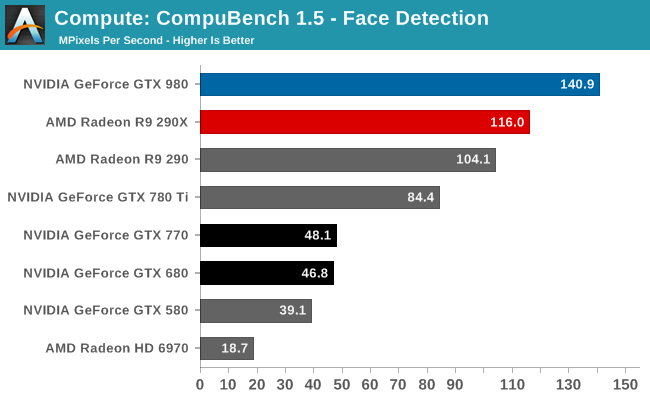
The first sub-benchmark is Face Detection, which like LuxMark puts GTX 980 in a very good light. It’s quite a bit faster than GTX 780 Ti or R9 290X, and comes close to trebling GTX 680.
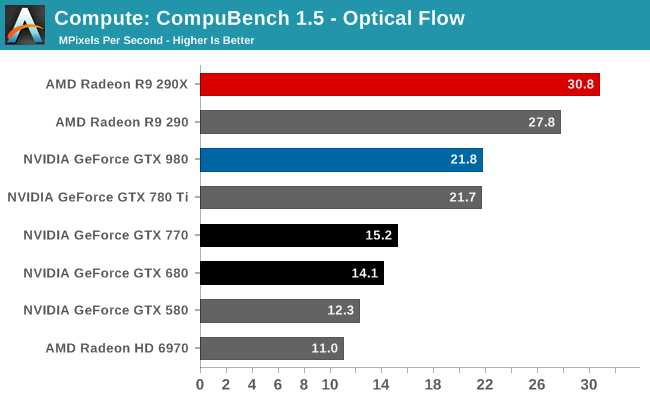
The second sub-benchmark of Optical Flow on the other hand sees AMD put GTX 980 in its place. GTX 980 fares only as well as GTX 780 Ti here, which means performance per CUDA core is up, but not enough to offset the difference in cores. And it doesn’t get GTX 980 anywhere close to beating R9 290X. As a computer vision test this can be pretty memory bandwidth intensive, so this may be a case of GTX 980 succumbing to its lack of memory bandwidth rather than a shader bottleneck.
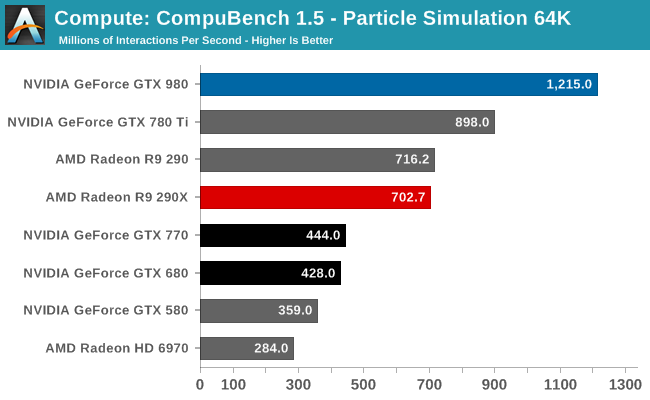
The final sub-benchmark of the particle simulation puts GTX 980 back on top, and by quite a lot. NVIDIA does well in this benchmark to start with – GTX 780 Ti is the number 2 result – and GTX 980 only improves on that. It’s 35% faster than GTX 780 Ti, 73% faster than R9 290X, and GTX 680 is nearly trebled once again. CUDA core occupancy is clearly a big part of these results, though I wonder if the L2 cache and shared memory increase may also be playing a part compared to GTX 780 Ti.
Our 3rd compute benchmark is Sony Vegas Pro 12, an OpenGL and OpenCL video editing and authoring package. Vegas can use GPUs in a few different ways, the primary uses being to accelerate the video effects and compositing process itself, and in the video encoding step. With video encoding being increasingly offloaded to dedicated DSPs these days we’re focusing on the editing and compositing process, rendering to a low CPU overhead format (XDCAM EX). This specific test comes from Sony, and measures how long it takes to render a video.
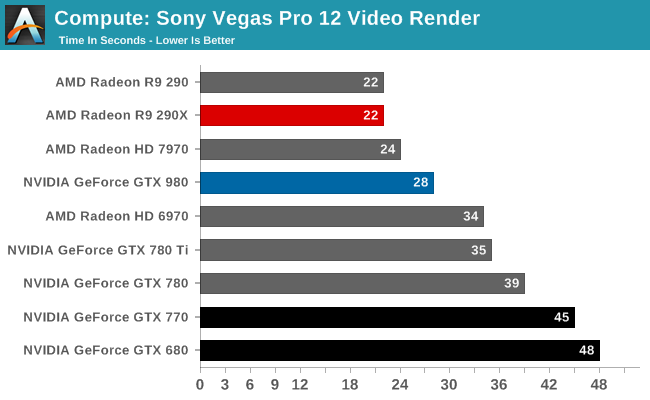
Traditionally a benchmark that favored AMD, the GTX 980 doesn’t manage to beat the R9 290X, but it closes the gap significantly compared to GTX 780 Ti. This test is a mix of simple shaders and blends, so it’s likely we’re seeing a bit of both here. More ROPs for more blending, and improved shader occupancy for when the task is shader-bound.
Moving on, our 4th compute benchmark is FAHBench, the official Folding @ Home benchmark. Folding @ Home is the popular Stanford-backed research and distributed computing initiative that has work distributed to millions of volunteer computers over the internet, each of which is responsible for a tiny slice of a protein folding simulation. FAHBench can test both single precision and double precision floating point performance, with single precision being the most useful metric for most consumer cards due to their low double precision performance. Each precision has two modes, explicit and implicit, the difference being whether water atoms are included in the simulation, which adds quite a bit of work and overhead. This is another OpenCL test, utilizing the OpenCL path for FAHCore 17.
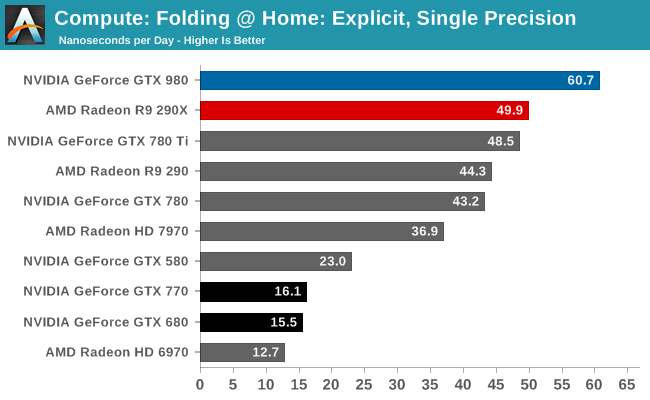
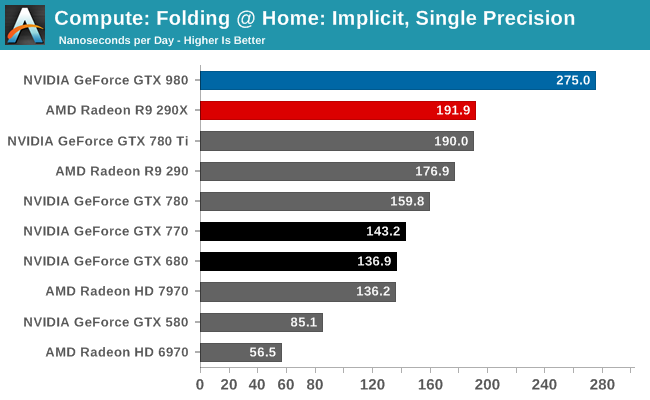
This is another success story for the GTX 980. In both single precision tests the GTX 980 comes out on top, holding a significant lead over the R9 290X. Furthermore we’re seeing some big performance gains over GTX 780 Ti, and outright massive gains over GTX 680, to the point that GTX 980 comes just short of quadrupling GTX 680’s performance in single precision explicit. This test is basically all about shading/compute, so we expect we’re seeing a mix of improvements to CUDA core occupancy, shared memory/cache improvements, and against GTX 680 those register file improvements.

Double precision on the other hand is going to be the GTX 980’s weak point for obvious reasons. GM204 is a graphics GPU first and foremost, so it only has very limited 1:32 rate FP64 performance, leaving it badly outmatched by anything with a better rate. This includes GTX 780/780 Ti (1:24), AMD’s cards (1:8 FP64), and even ancient GTX 580 (1:8). If you want to do real double precision work, NVIDIA clearly wants you buying their bigger, compute-focused products such as GTX Titan, Quadro, and Tesla.
Wrapping things up, our final compute benchmark is an in-house project developed by our very own Dr. Ian Cutress. SystemCompute is our first C++ AMP benchmark, utilizing Microsoft’s simple C++ extensions to allow the easy use of GPU computing in C++ programs. SystemCompute in turn is a collection of benchmarks for several different fundamental compute algorithms, with the final score represented in points. DirectCompute is the compute backend for C++ AMP on Windows, so this forms our other DirectCompute test.

Once again NVIDIA’s compute performance is showing a strong improvement, even under DirectCompute. 17% over GTX 780 Ti and 88% over GTX 680 shows that NVIDIA is getting more work done per CUDA core than ever before. Though this won’t be enough to surpass the even faster R9 290X.
Overall, while NVIDIA can’t win every compute benchmark here, the fact that they are winning so many and by so much – and otherwise not terribly losing the rest – shows that NVIDIA and GM204 have corrected the earlier compute deficiencies in GK104. As an x04 part GM204 may still be first and foremost consumer graphics, but if it’s faced with a compute workload most of the time it’s going to be able to power on through it just as well as it does with games and other graphical workloads.
It would be nice to see GPU compute put to better use than it is today, and having strong(er) compute performance in consumer parts is going to be one of the steps that needs to happen for that outcome to occur.










274 Comments
View All Comments
Laststop311 - Saturday, September 20, 2014 - link
I'm going to wait for the custom gtx 980's. It was already throttling from reaching the 80C limit on most games. Blower design wouldn't of throttled if they left the vapor chamber in but they didnt. My case has plenty of airflow so i don't require a blower design. MSI twin frozr V open air design will cool the gpu much better and stop it from throttling during gaming. People rushing to buy the reference design are missing out on 100's of mhz due to thermal throttle.chizow - Saturday, September 20, 2014 - link
Yep the open-faced custom coolers are definitely better at OC'ing, especially in single-GPU configs, but the problems I have with them are:1) they tend to have cheaper build quality than the ref, especially the NVTTM cooler which is just classy stuff. The custom coolers replace this with lots and lots of plastic, visible heatpipes, cheapo looking fans. If I wanted an Arctic Accelero on my GPUs I would just buy one.
2) they usually take longer to come to market. Frequently +3-6 weeks lead time. I know its not a super long time in the grand scheme of things, but I'd rather upgrade sooner.
3) The blowers tend to do better in SLI over longer periods of time, and also don't impact your CPU temps/OC as much. I have a ton of airflow too (HAF-X) but I still prefer most of the heat being expelled from the start, and not through my H100i rad.
4) Frankly I'm not too worried about squeezing the last 100-150MHz out of these chips. There was a time I might have been, but I tend to stick it to a safe OC about 100-150MHz below what most people are getting and then call it a day without having to do a dozen 3DMark loops to verify stability.
Laststop311 - Sunday, September 21, 2014 - link
Did you see the benchmarks. Some games were running in the 900's some in the 1000's some in 1100's. Stuck at these frequencies because the card was riding the 80C limit. As the review mentioned these aren't the same titan coolers as they removed the vapor chamber and replaced it with regular heatpipes. Getting a custom cooled card isnt about squeezing the last 100-150 from an OC its about squeezing an extra 400-600 mhz from an OC as many reviewers have gotten the gtx 980 to OC to 1500mhz. We are talking a massive performance increase from getting the proper cooling bigger than even the r9 290x going from reference to custom and that was pretty big itself.Laststop311 - Sunday, September 21, 2014 - link
Even to get the card to reliably run at stock settings during intense gaming you need a custyom cooled card. The reference cooled card can't even reliably hit its stock clock under intense gaming because the blower cooler without vapor chamber sucks.chizow - Sunday, September 21, 2014 - link
No, you can adjust the Nvidia fan and GPU temp settings to get sustained Boosts. There is a trade-off in terms of fan noise and/or operating temps, but it is easy to get close to the results of the custom coolers at the expense of fan noise. I personally set my fan curve differently because I think Nvidia's 80C target temp profile is a little bit too passive in how quickly it ramps up fanspeeds. I don't expect to have any problems at all maintaining rated Boost speed, and if I want to overclock, I fully understand the sacrifice will be more fan noise over the custom coolers, but the rest of the negatives regarding custom coolers makes the reference cooler more appealing to me.venk90 - Thursday, September 18, 2014 - link
The GTX 980 page on NVIDIA website seems to indicate HDMI 1.4 as it says 3840*2160 at 30 Hz over HDMI (it is mentioned as a foot note). Are you sure about it being HDMI 2.0 ?Ryan Smith - Thursday, September 18, 2014 - link
Yes. I've confirmed it in writing and in person.vegitto4 - Thursday, September 18, 2014 - link
Hi Ryan, great review! There will be the usual HTPC perspective? For example, did they fix the 23.976 refresh rate as Haswell does? I think it's important to know how these work as htpc cards. RegardsRyan Smith - Thursday, September 18, 2014 - link
For this article there will not. These cards aren't your traditional HTPC cards. However we can possibly look into it for next week's follow-up.chizow - Friday, September 19, 2014 - link
I think the definition of HTPC is beginning to change though, and while these may not yet fit into traditional HTPC (Brix and NUC seem to be filling this niche more), they are definitely right in the SteamBox/BattleBox category.Honestly, SteamBox was the first thing that came to mind when I saw that 165W TDP on the GTX 980, we will be seeing a lot of GM204 variants in the upcoming years in SFF, LAN, SteamBox and gaming laptop form factors that is for sure.